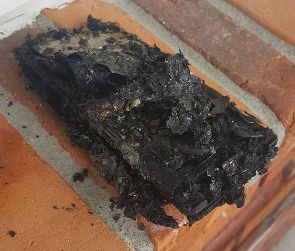 Remains of a Galaxy Note 7 Remains of a Galaxy Note 7
Samsung Strikes a Sour Note!
With the Galaxy Note 7 Smartphone Samsung becomes the latest company to recall a device. Stories of phones catching fire and images of burnt devices have been in the media for weeks now. It has been estimated that this fiasco will cost Samsung something in the neighborhood of five billion dollars. This has been a bad month and a serious black eye for the company.
First they tried to fix the problem with a software patch claiming that the problem was caused by charging or discharging too fast. While overcharging a Lithium Ion battery can cause overheating and subsequent fires that was not the issue in this case. The “fixed” phones still ignited.
Next Samsung issued a recall and told owners to stop using them. Shortly thereafter the U.S. Consumer Product Safety Commission also issued a recall. But the “safe” replacement phones still had the same problem. With the blunders mounting and sales plummeting a sense of confusion began to descend over the company and phone owners.
Finally Samsung announced that they are now issuing a recall of all Galaxy Note 7 devices On October 10, 2016 Samsung announced that it is halting sales. Shortly after that they officially canceled the phone. Disappointed customers are asked to return the phones. But with the millions of units sold there will almost certainly be some that, “slip through the cracks” and remain it the field.
If I have a Galaxy Not 7 should I keep using it?
NO! You should return it for an exchange, (for a different model) or refund. For more information visit the Samsung website at, (http://www.samsung.com/us/note7recall/?CID=AFL-hq-mul-0813-11000946) or call 1-800-SAMSUNG.
So how did this happen?
Samsung has not said exactly what went wrong but the general consensus is a “stackup” of production tolerances. Inside the battery there are two electrodes, (electrical conductors) called cathode and anode which are separated by a special dielectric barrier. The positively charged cathode is where the lithium “fuel” is stored. The anode holds the negatively charged ions. The two must never come in contact with each other but in the Galaxy Note 7 they did. The Verge has a good article on this at, (http://www.theverge.com/2016/9/8/12841342/why-do-phone-batteries-explode-samsung-galaxy-note-7).
Even with modern manufacturing all the parts are not exactly the same. The design calls for the part to be say .050 mm thick but allows for parts from say .049 mm to .051 mm to be used. If part “a” is a little on the plus side and Part “b” is also a little on the plus side when the two are assembled the combination may not fit into part “c” which is a little on the minus side.
Modern CAD software should have pointed this out to the designers. But in the race to cram more and more performance into smaller and smaller spaces the fine tolerances are sometimes exceeded.
Go back to the top
|